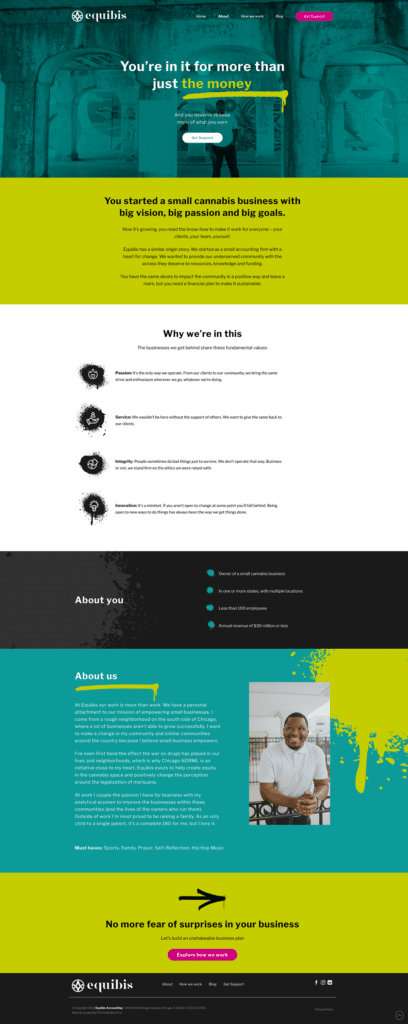
The purpose of an About page is to show potential clients
1) you understand them and know who they are
2) the real people they’ll be interacting with when they choose you as their accountant.
Traditionally speaking, About pages of websites have been filled with accolades of accountants who have 20 letters behind their name- most of which most people outside the accounting profession don’t know the meaning of. The page talks about school degrees and software affiliations and teams and what they like to do when they aren’t working (if you are lucky). What most About pages fail to communicate is anything, at all, about the ideal audience you are trying to reach.
It’s an extension of your Home page, just like all the other core pages on your website, however the difference is the Home page is a summary of the entire website and the About page is primarily an opportunity for you to further communicate how well you know your clients. It’s intended to continually build the bond between the client and your firm- the back and forth conversation on the page is helping them self identify, know you know them, and get to know you.
Your About page is not only about you.
When you’ve constructed a page that is only about you and your people, it can come across as an over inflation of your firm. A prospect might come to your page and think ‘these people seem nice and important’ but it doesn’t go any deeper than that. And it’s the connection (feeling seen, heard, and understood) that helps someone buy faster. “People buy from people” may be outdated and cliche in some industries now, because people buy from Amazon, but in this industry, it’s very true.
People care about who you are- but mostly they want to know if you can help solve their problem. It’s great you are a certified public accountant and all, but can you help them figure out cash flow? Can you give them more freedom to do what they want? Can you help them understand their numbers so they can make better business decisions?
That’s what they really want to know.
Make your About page better by showing your humanity.
Particularly in such a sensitive industry (you are dealing with money-which is the lifeblood of your client’s business) it’s important your client knows who you and your team are by more than a name.
It’s possibly even one of the reasons they are seeking you out in the first place. They want connection. They don’t want to be another number on a page or a cog in a wheel. It’s also a good way to help weed out clients who aren’t seeking connection and are solely looking for the best price on the market, those that aren’t ideal- and that’s good too, good marketing divides.
Your audience wants to see real images of the real people they will be working with on a daily basis. They want to read the words on the page and see a video and think “hey those are my kind of people.”
Other things you could add in to show your firm’s humanity and build connection:
- Your mission or story about why you work with this audience in the first place (we’ve got one client who has built his entire business around destigmatizing the cannabis industry and using his platform to build up the next generation of entrepreneurs).
- Your origin story and how your journey of building business connects with your audience’s journey (like Cheryl from Pink Pig who needed flexibility with her family and wanted that for her clients as well).
- Your greater purpose (James from Thrive has a major mission to see the accounting industry and those he works with to be transformed into ethically sustainable businesses)
Build trust by being the same person/people online as your potential clients will meet in person.
When people visit your website, read your blogs and see your social posts, they get an impression of the personality of your firm and of the people within it.
This impression is formed in part by the visual elements of your brand – your logo, design, images, colours. And it is also influenced by your messaging – the words you share and the voice you present in your marketing.
- Is an expression of your values.
- Builds trust through familiarity.
To get more clarity on your tone of voice, take a look at this spreadsheet we’ve created. You’ll be able to narrow down how you sound and start creating content based on those findings.
A great example of nailing tone of voice is Lord CPAs. Corey Lord knows his audience really well. He talks like they talk and he has a passion for his industry. The first major section of content is primarily a quote from something he said to us during his Foundations Workshop.

In that workshop, we talked in depth about his ideal audience- who they were, what they needed and how Lord CPAs helped to solve their problems.
As you can see above, this first portion of content speaks both to the passion Lord CPAs have for their clients and a recognition of how important their clients are to the entire community. This paragraph is building a relationship between Lord CPAs and the ideal client. The client recognizes Lord understands the importance they bring to the table and also sees the high value they put on their niche (the food and beverage industry).
Before you share team profiles, use your About page to build a bridge between you and your ideal client.
As you work your way down the page, you’ll continue to see the back and forth bridge building the About page maintains. It talks about the community/business a bit more, then shares who specifically Lord works with. Then it speaks a little more to the niche audience problems they are facing and what Lord does to help solve those problems. It then talks about the values that intersect for both Lord and their niche. After all that conversation, then the About page introduces the humans a client would be working with.

The ideal audience has been given ample opportunity to recognize Lord CPA know them and know them well. By the time they get to meeting the humans, it’s basically a slam dunk to becoming a client.
Here is a sample structure to model your About page after.
Core message: You’re not on this journey alone (helping them identify with a problem they have)
[Communicate that you know your clients well, and identify your ideal client.]
Core message:
You are…
You want…
You have XX employees.
You need…
[Specific pain points that are common for your niche]
[Identify your values and help them understand who you are and how you work.]
OUR TEAM
[HYPERLINK BUTTON > Here’s how we help> (to services page)]
[CALL TO ACTION > Schedule a call.]
[TRANSITIONAL CALL TO ACTION – Get free advice. >(to blog page)]
At a minimum, if you include the above elements, you’ll have the basic structure for a good About page. One that builds a bridge between your ideal audience and your firm.
*It’s also important to note this About page structure makes sense only as a part of an entire website structure. You’ll receive this deliverable after the website portion of Foundations.
Here’s an example of the basic structure you see above. It’s simple and gets to the point- covering all the necessary elements.

Make your About page even more impactful by sharing more than the bare minimum
There are several other elements you can include to create connection and show your ideal audience you are the firm they’ve been looking for.
Add a video from the team talking about values.
This can be a great way to help the prospect connect on a personal level. Hearing the team talk about the values, and what they mean in the day to day life of the firm, will give them an imagination for what it might look like to be a part of that in a small way when working with them.
It gives them the opportunity to hear the voices and see the facial expressions of people who will be in charge of the finances in their business.
A video also reinforces your brand. When the people in the video sound like the words on the website, your tone of voice is consistent and will build trust on a subconscious level.
Adding links to your social media channels give people another way to connect with you.
Particularly if they aren’t ready to buy, you can stay top of mind by showing up in their social feeds- they’ll be scrolling past images of cute puppies and snarky memes about long stoplights and there you’ll be, naturally, just waiting to interact with them 🙂
Speaking of cute puppies – social media is made to be personal and not just trends and memes. It’s about you seeing your clients’ family and them seeing yours. It’s about where they went to eat or what they love to do. When you see those things on a prospect’s feed, or they see them on yours, it gives you the opportunity to get to know one another and decide- are these really my people?
If you aren’t on social media you are missing out on massive opportunities to reach your ideal audience. When people put in the effort on social media, they see more traffic to their websites, more inquiries on their contact form and more signed proposals.
Your social channels are also an excellent way to continue tone of voice consistency. By showing up on videos and posting content that matters to your people, you’ll show them you understand and know them in a unique way.
If you’re unsure about how to use social media in a way that doesn’t feel “salesy” or like a bait and switch to get people to buy, read this article.
Essentially your social media sharing breaks down to these core elements.
- Build trust through sharing knowledge.
- Show your value by giving them what they want and selling them what they need.
- Mention your services by showing them how it solves their problems.
- Address their doubts, annoyances and fears.
- Be human by sharing personal experiences.
Doing these things will move your ideal client closer to working with you- which is what you want all along.
Add a link to your Careers page.
When you’re marketing your firm, you’re not only reaching potential clients, you’re reaching potential employees. They will be looking on your About page to get more information about who you are and the people you work with.
If they like what they see, they’ll want to easily find a place to apply for a position. This is where a quick link to your Careers page comes in handy.
Your About page is an excellent place to help your ideal audience further identify who you are, how you help them and the bridge between their business and yours. When done with intention, it builds further connection and allows your clients to get to know you and your team better, without feeling overwhelmed by everything being about you.
Now you’ve got all this About page knowledge and need to know what to do with it right? 🙂 It’s time to do an audit of your own.
Does your About page:
- have a balance of talking about your client and talking about your firm?
- sound like you?
- include real images of you and your team?
- share your values?
- include your social media profiles?
Making the above adjustments will help your About page draw in the right prospects and push the wrong ones away. If you’d like more help/resources/expert eyes to make your About page better, join the PF Lab! It’s a place to experiment and get coaching and feedback from the PF team and from other accountants like yourself.

